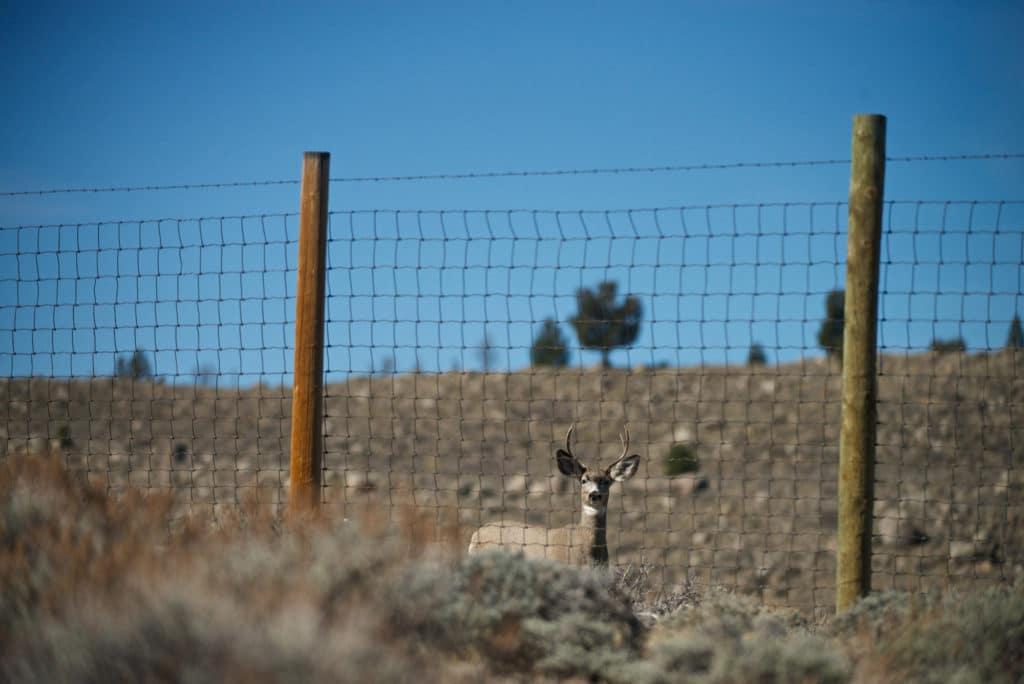
Wyoming Mule Deer Migrations (Red Desert to Hoback Basin)
Goals
A recognized model for conserving a big game migration corridor is the Red Desert to Hoback Basin (RD2H) route, which spans 150 miles in north to southwest Wyoming. It is the longest mule deer migration route in the lower 48.
The Wyoming Wildlife Federation (WWF) has created a conservation and outreach program for this migration. RD2H is now part of what is called the “Partnership” consisting of 14 nonprofit organizations, with WWF serving as a lead for grant funding and on-the-ground conservation activities. WWF staff members are working to conserve this corridor and developing measures that the organization can apply to other corridors in the state.
Scientists with the Wyoming Migration Initiative at the University of Wyoming, over the last several years have radio-collared mule deer to document the RD2H corridor. The conservation Partnership is now applying that scientific information to actions on the ground. To this end, WWF plans to hire a migrations coordinator to continue its work with private landowners to help conserve this vital migration corridor in Wyoming.
Private landowners are instrumental in this effort because 25 percent of the corridor goes through private land. Fencing and conserving habitat are the current focus areas. WWF, under the Partnership, has begun addressed animal mortality along this route caused by existing, not so wildlife-friendly fencing and through fencing modifications, based on Wyoming Game and Fish recommendations. In 2016, WWF received funding to purchase “wildlife-friendly” fencing materials, and has begun the work with private landowners to install fencing along 133 miles of the 150-mile corridor.
This outreach program also includes a landowner and public information campaign on the importance of conserving these important seasonal habitats. Good quality winter range and summer reproductive habitats are essential to the long term healthy of Wyoming’s big game species. The connectivity between these habitats – within the migration route – is the third essential component. Ensuring animals can move between their seasonal ranges each year is one of the most profound conservation actions we can take for our big game animals.
Objectives
This spring and early summer, WWF and its conservation partners will begin work to develop a migrations management strategy for inclusion in the BLM’s Rock Springs Office’s Resource Management Plan. This strategy will cover the recently designated Sublette Mule Deer Corridor (Rye Grass, Mesa, and Red Desert to Hoback herds).
WWF will move onto Phase 2 of the fencing modification of this program. WWF is currently soliciting additional funds to modify fencing (wildlife-friendly) for a total of approximately 133 miles of fence in the designated project area. The project area includes heavily travelled areas on the Wind River Front as well as crucial winter range for mule deer, as identified by Wyoming Game and Fish Department (WGFD).
PHASE 1: Total of 44 miles (COMPLETED) – Includes 18 miles of fence in Teton Diablo, Flying Fishhook, and Rolling Thunder ranches. We are in the process of visiting with additional ranchers as well as land management agencies within the Phase 1 area. We anticipate identifying additional cooperators as well as additional specific fence segments in the near future.
PHASE 2: A total of 52 fence miles have been identified for potential modification through a previous inventory. Additional miles may be identified with further inventory work.
WWF along with the Partnership will continue to implement its public outreach plan with several education opportunities on the importance of conserving the RD2H migration. WWF will also continue to be active in reaching out to additional private landowners on the fencing program and toward for our work to identify vital habitats, stopovers and bottlenecks and seasonal ranges along the RD2H migration route.
Benchmarks
A fence inventory has been completed throughout much of the project area (Phase 1-3). WWF’s intent is to finalize the inventory within the three phases and potentially expand the project area, pending interest from landowners/management agencies and funding. Prioritization of the three phases was based on WGFD recommendations and initial landowner input/interest. Additional landowners have expressed an interest and are willing to participate pending funding.
WWF has completed nearly all the fencing projects under Phase 1 of this project and will move onto Phase 2 in spring/summer of 2017. The Phase 2 work will begin with fence modifications/construction on the Teton Diablo Ranch.
2016 Accomplishments
The Partnership: Fourteen organizations and private citizen representation form the core of the Partnership, representing sportsmen, conservationists, land trusts, landowners, and science. Together, they bring a wealth of information, resources and skills to address the complex issues that long distance migrations face.
Migrations Management: After a year-long process with stakeholders, in the spring of 2016 the Fish and Game Commission adopted a set of definitions for the state’s big game migrations. These definitions will help mitigate the impacts of development and are now included in the Game & Fish Department’s wildlife seasonal range definitions and recognized in the Commission’s Mitigation Policy. Also developed was a process for making recommendations to land management agencies and other decision makers on how to minimize the impacts to migration corridors caused by various types of development.
The Wyoming Wildlife Federation was a major player in this Game & Fish stakeholder effort to craft the migration definitions. But more work remains for this important management strategy for big game migrations. WWF will continue its role by working with Game & Fish to develop a map for designated corridors that fall within the state and one that is based on the data and the definitions approved by the Commission. WWF will also work to help craft recommendations for specific management actions that can be tied to these corridors.
Click here to read our op-ed on migrations.
Red Desert to Hoback Deer Migration (.pdf), University of Wyoming

